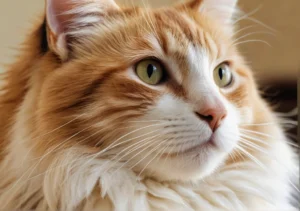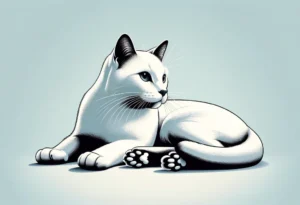Cats’ black claws may seem like a mysterious feature, but there is a simple explanation behind their coloration. Here, we explore the reasons why cats have black claws and unravel the interesting facts surrounding this unique trait.
The Biology Behind Black Claws
Have you ever wondered why some cats have black claws while others have clear or white claws? Well, the color of a cat’s claws actually comes down to genetics and the presence of a pigment called melanin. Just like how melanin determines the color of our skin and hair, it also plays a role in determining the color of a cat’s claws.
Cats with black claws have a higher concentration of melanin in their claws compared to cats with lighter-colored claws. This increased melanin production is often influenced by a cat’s genetic makeup. So, if a cat inherits the genes for more melanin production, they are more likely to have black claws.
Additionally, the black color of a cat’s claws can also serve as a camouflage mechanism, especially for cats that rely on hunting in the wild. The dark color helps them blend into their surroundings, making it easier to catch prey without being noticed.
Evolutionary Advantages
Having black claws may provide cats with a few evolutionary advantages in both the wild and domestic settings. In the wild, black claws can help cats stalk and catch prey more efficiently by remaining unseen. This stealthy advantage allows them to sneak up on their prey without giving themselves away due to the color of their claws.
In a domestic setting, black claws can also be beneficial. Cats that spend time outdoors may use their black claws for climbing trees or defending themselves from potential threats. The darker color can help hide dirt and debris, making their claws less noticeable and aiding in their stealthy movements.
Overall, the black color of a cat’s claws is not only a genetic trait but also a tool that provides them with certain advantages in different environments. So, the next time you admire your cat’s sleek black claws, remember that they serve a purpose beyond just aesthetics.
Black Claws in Different Breeds
Did you know that the color of a cat’s claws can vary depending on its breed? While most cats have black claws, certain breeds exhibit unique characteristics. For example, Russian Blue cats have black claws with silver tips, giving them a distinguished appearance. On the other hand, Siamese cats typically have clear or white claws, standing out amidst their sleek bodies. It’s fascinating to see how each breed has its own twist on the traditional black claws, adding to their individual charm.
The Role of Grooming
When it comes to a cat’s claws, grooming plays a crucial role not only in their appearance but also in their overall health. Regular grooming helps maintain the sharpness of the claws, ensuring they can retract properly. This action prevents the claws from snagging on surfaces and potentially causing injury. Additionally, grooming can impact the color of a cat’s claws. By keeping them clean and trimmed, the claws can appear darker and healthier. So, remember to incorporate regular grooming sessions into your cat care routine to keep those claws in top-notch condition.
- Trimming: Regularly trim your cat’s claws to prevent overgrowth and maintain their health.
- Scratching Posts: Provide scratching posts to encourage natural claw maintenance and prevent damage to furniture.
- Cleanliness: Keep your cat’s paws clean to maintain the appearance and health of their claws.
- Veterinary Care: Regular veterinary check-ups can help monitor the condition of your cat’s claws and address any issues promptly.
- Positive Reinforcement: Use positive reinforcement during grooming sessions to make the experience enjoyable for your cat. Remember, a happy cat means healthy claws!
Interesting Trivia: Cat Claw Color Myths
Black claws on cats often lead to misconceptions and myths about their color. One common myth is that all cats with black claws have black fur – not true! Claw color is actually determined by the cat’s genetics, not their fur color. Another myth suggests that black claws are sharper or more dangerous than other colors. In reality, all cat claws are sharp and can cause scratches if not properly maintained.
Now, here’s an interesting insight: Did you know that a cat’s claws may appear black due to the presence of melanin, which is the same pigment responsible for dark hair and skin in humans? This pigment gives the claws their color and can vary in intensity, resulting in different shades of black in cat claws. Pretty neat, huh?
Black Claw Care Tips
Keeping your cat’s black claws healthy is essential for their well-being. Regular nail trimming is crucial to prevent overgrowth and potential issues with scratching furniture or people. Use a quality cat nail clipper and start by trimming small amounts at a time to avoid cutting the quick, which can be painful for your furball.
To make nail trimming a positive experience, associate it with treats or playtime to reward your cat. If your furry friend is resistant to nail clipping, consider seeking assistance from a professional groomer or veterinarian. Remember, keeping your cat’s claws trimmed is not only beneficial for them but also for your own comfort and the preservation of your home furnishings.
Here are some additional tips for black claw care: 1. Provide scratching posts: Encourage your cat to scratch appropriate surfaces to help maintain their claws. 2. Check for signs of infection: Monitor your cat’s claws for any redness, swelling, or discharge, which could indicate an infection. 3. Consider nail caps: If your cat has a tendency to scratch excessively, nail caps may be a non-invasive solution to protect furniture.
By following these care tips, you can ensure your cat’s black claws remain healthy and strong, benefiting both your pet and your living space.
Famous Black-Clawed Cats
Black claws give cats a sense of mystery and elegance, adding to their charm. Some well-known felines with distinctive black claws have made their mark on popular culture. The iconic animated character, Sylvester from Looney Tunes, is instantly recognizable with his black claws. Another famous black-clawed cat is Salem Saberhagen from the TV show “Sabrina the Teenage Witch,” whose sharp black claws often added a playful element to his mischievous antics.
Black Claws vs. Other Animals
While cats have black claws due to the presence of a dark pigment called melanin in their nail tissue, other animals have claws of varying colors serving different functions. Primates like gorillas have a pinkish color to their claws, aiding in grooming and climbing. Birds of prey like eagles have sharp, curved talons in various shades, providing a deadly grip for hunting. In contrast, black bears rely on their retractable claws for climbing trees and digging, which are usually dark in color to blend in with their fur.
Insight: The black coloration of cat claws may have evolved as a camouflage strategy to mimic the appearance of dirt, aiding in hunting by disguising their movements and enhancing their stealth in natural environments.
Environmental Influences on Claw Color
Ever wondered why some cats have black claws while others have clear or white ones? The color of a cat’s claws can actually be influenced by various environmental factors like diet, sunlight exposure, and overall health.
Diet: Just like with humans, a cat’s diet can impact the color of their claws. Foods rich in certain nutrients like zinc and biotin can contribute to healthier, darker claws. Make sure your furball is munching on a well-balanced diet to keep those claws in top shape.
Sunlight Exposure: Believe it or not, sunlight can also play a role in the color of a cat’s claws. Cats that spend more time in the sun may have darker claws due to increased melanin production. So, if your kitty loves lounging in a sunny spot, their claws might be more likely to have a darker hue.
Overall Health: A cat’s overall health can affect the color of their claws as well. Cats that are healthy and well-nourished are more likely to have strong, dark claws. Regular check-ups with your vet, proper nutrition, and plenty of playtime can all contribute to keeping your cat’s claws looking their best.
In addition to these environmental factors, genetics also play a role in determining the color of a cat’s claws. So, while you can’t change your cat’s genetics, you can certainly help maintain their claw health by providing a balanced diet, plenty of sunlight, and regular veterinary care. After all, healthy claws are happy claws!
Alex, a passionate animal lover, has experience in training and understanding animal behavior. As a proud pet parent to two dogs and three cats, he founded AnimalReport.net to share insights from animal experts and expand his knowledge of the animal kingdom.




